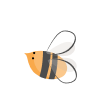- 2 months ago
What to Do If Your Child Frequently Gets a Stye?
What Is a Stye and Why Does It Occur?
A stye is an inflamed, red, swollen, and often painful bump on the eyelid, usually due to blockage and infection of oil glands. There are two types:
- External stye: On the outer edge of the eyelid
- Internal stye: Inside the eyelid, more painful and deeper
Main Causes:
- Staphylococcus aureus infection
- Poor hand and eye hygiene
- Touching or rubbing the eyes with dirty hands
- Blocked eyelid glands (Meibomian glands)
- Weak immune system
Why Do Some Children Get Styes Frequently?
1. Inadequate Eye Hygiene
- Irregular handwashing
- Rubbing eyes with unclean hands
- Sharing towels with others
2. Chronic Eyelid Inflammation (Blepharitis)
- Redness and flaking along the eyelid margins
- Chronic blockage of oil glands
- A major contributor to recurrent styes
3. Low Immunity
- Children with frequent illnesses may have a weaker immune response
- Nutritional deficiencies or chronic illnesses should be assessed
4. Allergic Eye Conditions
- Itchy eyes lead to frequent rubbing
- Associated with seasonal allergies or atopic tendencies
5. Eyelid Structural Issues
- Inward turning eyelid margins
- Overactive oil glands or congenital anomalies
What Should You Do for Frequent Styes?
1. Improve Hygiene Practices
- Teach children to wash hands regularly
- Avoid rubbing eyes
- Use personal, clean towels
2. Warm Compresses
- Apply a clean cloth soaked in warm water to the eyelid 3–4 times a day
- Helps unblock oil glands and improve circulation
3. Ophthalmologist Evaluation
- Assess eyelid anatomy
- Chronic blepharitis or gland dysfunction may need targeted therapy
4. Medication (If Needed)
- Antibiotic eye drops or ointments
- Oral antibiotics in more severe or persistent cases
- Eyelid cleansing wipes or mild baby shampoo cleanses
5. Immune and Allergy Assessment
- Look for patterns of frequent infections
- Blood tests or allergy screening if clinically indicated
When to See a Doctor
Seek medical advice if:
- The stye doesn’t improve within a week
- There is severe pain, swelling, or vision changes
- The same area is repeatedly affected
- The bump becomes large, red, or begins to drain pus
- Eyelid deformity or scarring starts to develop
How to Prevent Recurrent Styes in Children
- Teach and reinforce hand and face hygiene
- Consider multivitamin or immune support in consultation with a doctor
- Maintain regular sleep and a healthy diet
- Control allergies and reduce eye rubbing
- For older children wearing contact lenses, ensure proper lens hygiene













